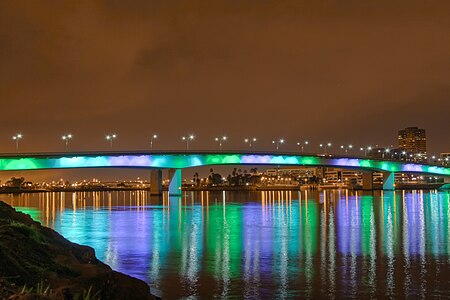Queensway Twin Bridges
Box girder bridges in the United StatesBridges completed in 1970Bridges in Los Angeles County, CaliforniaBuildings and structures in Long Beach, CaliforniaLos Angeles Harbor Region ... and 3 more
Pages containing links to subscription-only contentRoad bridges in CaliforniaSteel bridges in the United States

The Queensway Twin Bridges (sometimes Queens Way Bridges or Queensway Bay Bridge) connect downtown Long Beach with the outer Port of Long Beach. They are the southernmost crossing of the Los Angeles River, near the mouth of the river, where it empties into Queensway Bay, and they are the primary arterial link between Long Beach and RMS Queen Mary. The bridges were completed in June 1970 and opened on October 5, 1970.
Excerpt from the Wikipedia article Queensway Twin Bridges (License: CC BY-SA 3.0, Authors, Images).Queensway Twin Bridges
Queens Way, Long Beach
Geographical coordinates (GPS) Address Nearby Places Show on map
Geographical coordinates (GPS)
| Latitude | Longitude |
|---|---|
| N 33.759985 ° | E -118.199294 ° |
Address
Queensway Twin Bridges
Queens Way
90834 Long Beach
California, United States
Open on Google Maps





